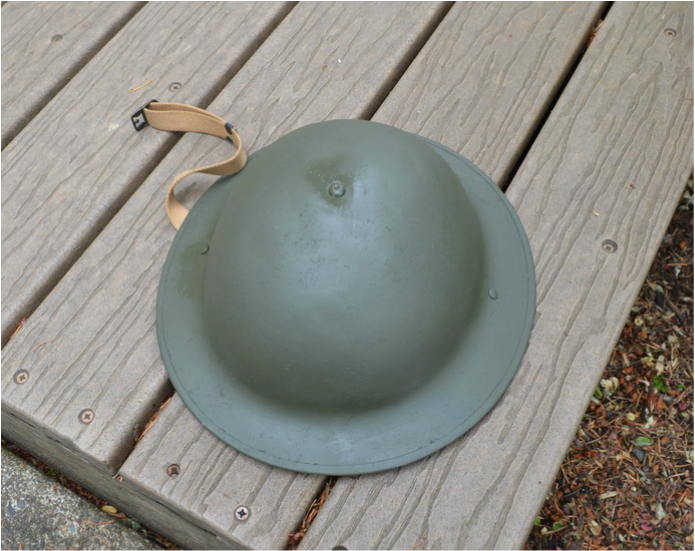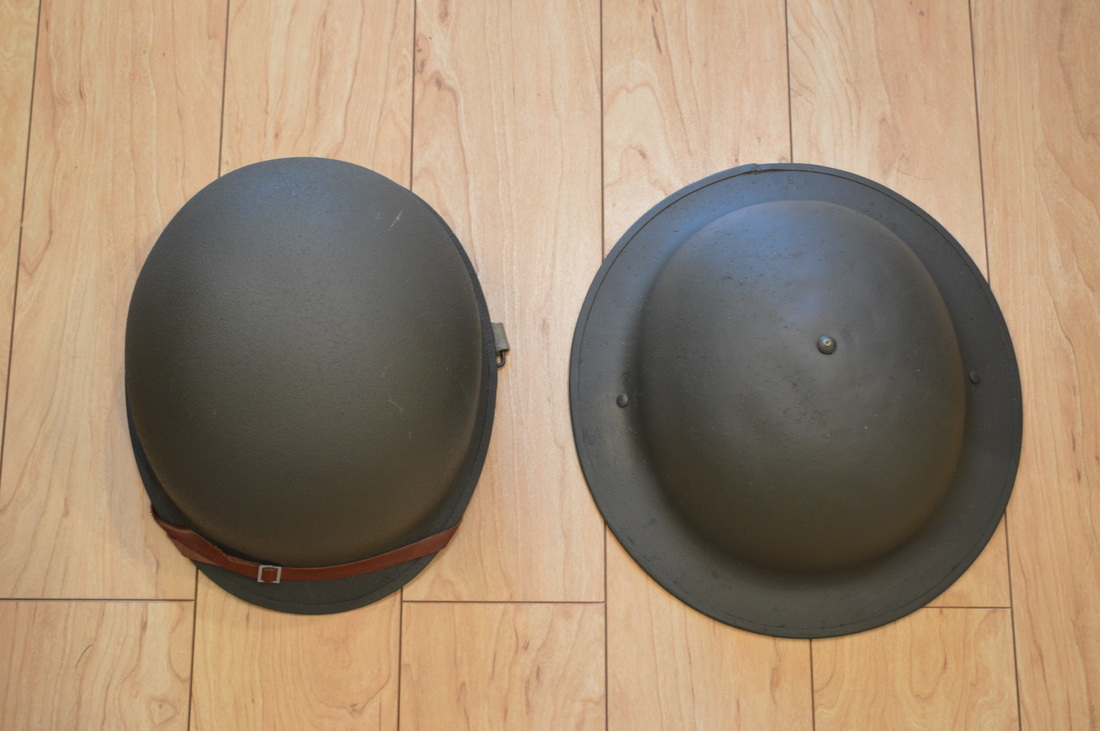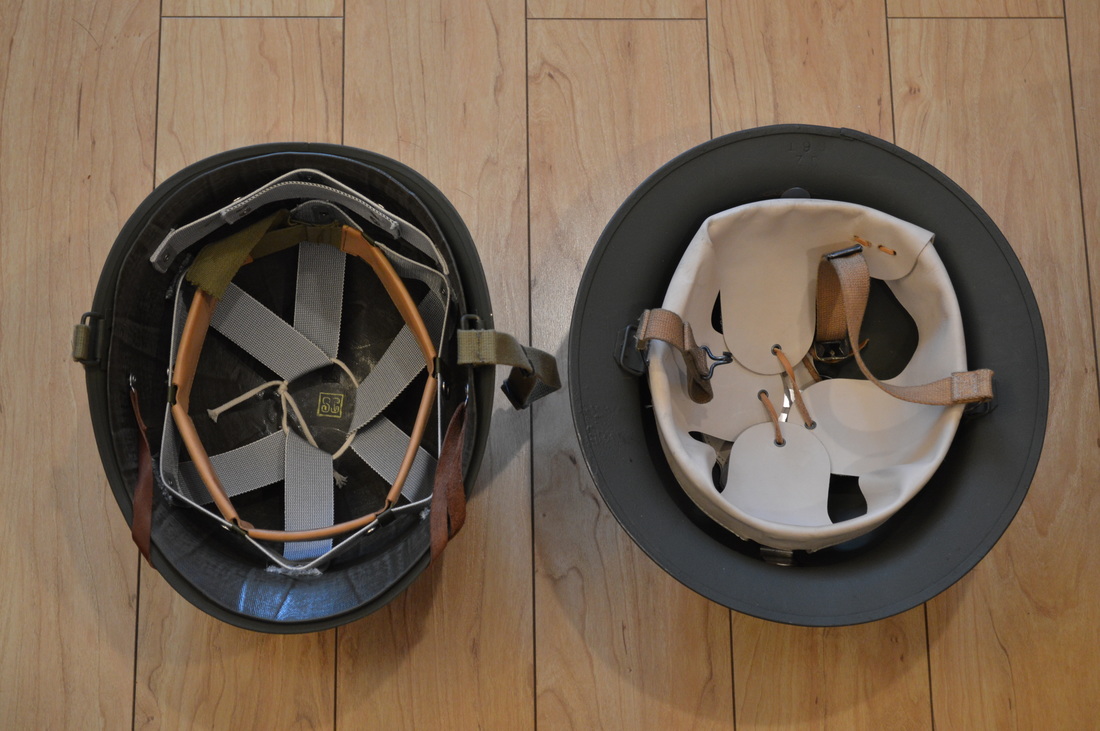Various US army experiments led to the iconic M1 helmet, adopted at the end of 1941. As a stop gap, old M1917 helmets were refitted with new liners copied straight from the experimental 5A helmet, which would not be adopted. The 1917A1 possessed an improved suspension system made from leather over a sheet metal frame. By 1940, McCord Radiator Co. was granted a contract for new M1917A1 helmets as the military expanded and the draft began to overcome the extreme shortfall in manpower to even begin to approach a wartime footing. The M1917A1 was not intended to serve indefinitely. It was retained and even newly manufactured through much of 1941 because it was already in use. When the M1 helmet became available, the ‘17A1’s were quickly phased out in all branches of the US military by the fall of 1942.
|
The M1917 Helmet was one of a multitude of variations of the “Brodie” Helmet developed during WWI, first by the British, and then later by Commonwealth and American forces. The Brodie was a simple answer to the vast bounds that artillery technology had made in the prior century. Once the stalemate of the trenches set in by the winter of 1914-1915, the combatants on the Western front began to lash out at one another with millions artillery shells. Head wounds inflicted by shrapnel began to climb, and all the combatants found a means of producing a then modern ballistic helmet to protect the wearer’s head from overhead shell splinters. The M1917 helmet was simply an American adoption of the British Mk. I Brodie helmet, and until American production was in full swing, most American troops to see action in WWI were issued British made helmets. However, tens of thousands of American made (and even a few British made) M1917 helmets remained in inventory until the 1930’s. It had been noted in official American and British reports that the overall Brodie design had severe shortcomings when it came to protecting the side and back of the wearer’s head from shell fragments. Air bursts and falling debris were little issue when the individual was protected by a trench, but in more mobile circumstances, the German “Stahlhelm” offered superior overall protection, both due to the hardness of the steel and its deeper shape. Various US army experiments led to the iconic M1 helmet, adopted at the end of 1941. As a stop gap, old M1917 helmets were refitted with new liners copied straight from the experimental 5A helmet, which would not be adopted. The 1917A1 possessed an improved suspension system made from leather over a sheet metal frame. By 1940, McCord Radiator Co. was granted a contract for new M1917A1 helmets as the military expanded and the draft began to overcome the extreme shortfall in manpower to even begin to approach a wartime footing. The M1917A1 was not intended to serve indefinitely. It was retained and even newly manufactured through much of 1941 because it was already in use. When the M1 helmet became available, the ‘17A1’s were quickly phased out in all branches of the US military by the fall of 1942. My own M1917A1 helmet is a refurbished and restored M1917 shell covered in a previous post. Using parts and a sturdy, well made reproduction liner from Prarie Flower and Leather Co, I was able to restore it back to 1936 specifications. Overall, the helmet sits nicely on the head. However, the helmet was not designed to remain on the wearer’s head without the chinstrap securely fastened. If tightened down too far it can become uncomfortable. The liner simple doesn’t contact enough of the wearer’s head, and therefore spread out the weight. Simply put, the helmet feels somewhat heavier than it is, and that makes the ‘17A1 somewhat more fatiguing to wear for extended periods compared to a WW2 US Military specification liner. Also, the ‘17A1 has a tendency to slide around and shift position while running, a problem I have not noticed in similarly athletic circumstances with my own M1 helmet so long as the liner is properly adjusted. If worn during the execution of the manual of arms, the rifle’s handguard tends to ding the Brodie helmet’s brim when being shouldered. The M1917A1 was ultimately a product of its time; it was not what was needed, but it was what could be obtained and mass produced. It was an early, first generation helmet, better than nothing, but can be forgiven for not being advanced or state of the art. By WWII, the M1would replace it and create a helmet superior even to the vaunted German Stahlhelm. The M1917A1 was a key player in the early, dark days of the war, and it served well until the M1 could take its place.
1 Comment
Sheldon Johnson
4/4/2024 09:10:51 am
I have a Model 17A1 in gorgeous condition with a U.S. !930s "Pinwheel" Aviation Insignia (Blue & Yellow) painted on the Front. I would like to sell it, can provide photos to anyone who may be interested and have it priced @ $450.00. If you know of anyone who might be interested, please let me know. Thank you, Sheldon Johnson.
Reply
Leave a Reply. |
Archives
July 2021
Categories |




 RSS Feed
RSS Feed
